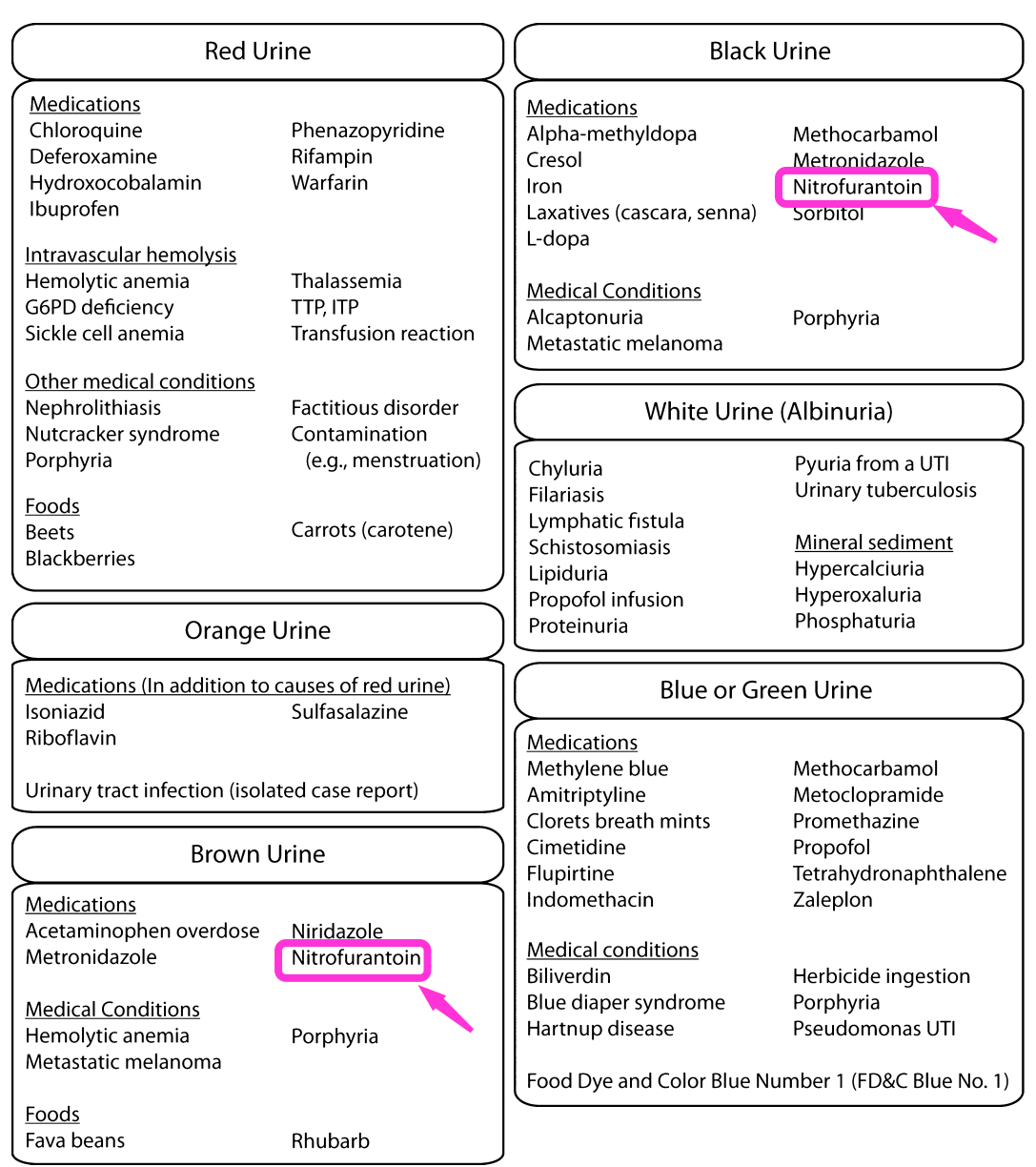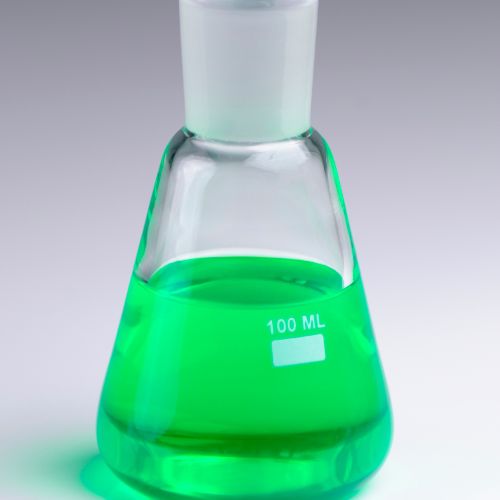The short answer:
Nitrofurantoin can cause urine color changes, typically resulting in dark yellow or brown urine. This is a common and harmless side effect of the medication. However, if you experience additional symptoms or have concerns, consult your healthcare provider for guidance.
Key Facts:
- Nitrofurantoin is an effective treatment for urinary tract infections, but it can cause noticeable changes in your urine.
- Specifically, you may observe that your urine turns dark yellow or brown while on this medication.
- The darkening of the urine results from the presence of nitrofurantoin metabolites or end products in the urine, making it look darker.
- The alteration in urine color is a widespread side effect, impacting many nitrofurantoin patients.
- Dark yellow/brown urine is benign and temporary.
- Nitrofurantoin use does not typically result in orange urine.
- While urine color changes induced by nitrofurantoin can be worrisome, they are usually harmless and should not cause you to discontinue your medication.
Fact #1: Nitrofurantoin causes dark yellow to brown urine.
Nitrofurantoin is an effective treatment for urinary tract infections, but it can cause noticeable changes in your urine.
Specifically, you may observe that your urine turns dark yellow or brown while on this medication.
Let’s explain the reasons behind this side effect and what to anticipate.
- Prevalence: The alteration in urine color is a widespread side effect, impacting many patients using nitrofurantoin. Most individuals will encounter this change to some degree during their therapy.
- How does it look: The primary sign you’ll observe is a shift in urine color, ranging from dark yellow to brown. The change in urine color is often not associated with other symptoms such as jaundice, rash, blood in urine, etc. Sometimes, Nitrofurantoin may induce very dark brown or black urine (reference).
- Onset and duration: The change in urine color can emerge shortly after starting nitrofurantoin therapy and might persist for the duration of your treatment.
- Why nitrofurantoin causes dark yellow or brown urine: The darkening of the urine results from the presence of nitrofurantoin metabolites or end products in the urine, making it look darker (reference). As your body processes the medication, these metabolites are eliminated in the urine, causing a dark yellow or brown hue.

Don’t hesitate to contact your doctor if you have any concerns regarding this side effect or any other aspect of your nitrofurantoin treatment. You must feel at ease and knowledgeable about your medications.
Fact #2: Dark yellow/brown urine is benign and temporary.
As a medical professional, I want to reassure you that the deep yellow or brown urine you might experience while using certain medications, such as nitrofurantoin, is generally harmless and short-lived.
While using the medication, you may observe that your urine becomes darker, varying from a deep yellow to brown to black. Always remember that this transformation is anticipated and should not cause worry.
The darkening of your urine is often short-lived and will subside after you finish your nitrofurantoin course or cease using the medication. The urine should return to its typical color within several days after stopping the drug.
When to worry:
If you feel uneasy or apprehensive about the change in urine color, please remember that it is a widespread side effect and is generally harmless.
However, if the color alteration is accompanied by other symptoms such as discomfort, jaundice, fever, or a potent odor, reach out to your medical professional to exclude any potential complications.
Stay well-hydrated:
Consume ample water while using the medication to help dilute your urine and lessen the discoloration.
Sufficient hydration is also crucial for preserving overall kidney health and ensuring proper medication elimination.
Fact #3: Continuing medication is essential despite urine color alterations caused by nitrofurantoin.
Feeling apprehensive when you notice your urine changing color while taking nitrofurantoin is natural. However, these color changes, which usually manifest as dark yellow or brown, are expected and harmless side effects of the medication.
To effectively combat your urinary tract infection, you must continue taking nitrofurantoin as prescribed by your healthcare provider.
If you have worries or encounter additional symptoms, seek your doctor’s advice, but refrain from discontinuing the medication without their consent.
Fact #4: In rare instances, nitrofurantoin leads to brown urine and jaundice due to liver impact.
Occasionally, nitrofurantoin can cause brown urine and jaundice (yellowing of the skin and eyes) due to liver involvement. This side effect is infrequent but potentially severe.
If you observe brown urine accompanied by jaundice, fatigue, abdominal discomfort, or dark-colored stools, it’s crucial to reach out to your healthcare provider immediately. They might need to assess your liver function and decide if an alternative treatment is necessary.
The table below tells you how to differentiate between benign nitrofurantoin-induced dark or brown urine and nitrofurantoin-induced liver affection (reference):
| Aspect | Brown Urine Due to Nitrofurantoin Excretion | Brown Urine Due to Nitrofurantoin-Induced Liver Injury |
|---|---|---|
| Cause | Presence of nitrofurantoin metabolites in the urine | Liver dysfunction leads to increased bilirubin levels in the urine |
| Frequency | Common and expected side effects | Rare and potentially serious side effects |
| Onset | This can occur shortly after starting nitrofurantoin treatment | May develop over time, potentially after weeks or months of treatment |
| Resolution | Typically resolves after the medication is discontinued or after the course of treatment is completed. | Requires medical intervention and discontinuation of nitrofurantoin; may take time to resolve after stopping the medication |
| Associated Symptoms | Usually, no other symptoms beyond the color change | Possible symptoms include jaundice (yellowing of the skin and eyes), dark urine, pale stools, fatigue, abdominal pain, nausea, vomiting, and loss of appetite. |
| Severity | Generally harmless and temporary | Potentially severe and requires medical attention |
| Need for Medical Consultation | Not usually necessary, but consult a healthcare provider if concerned or if the color change persists after stopping the medication. | Immediate consultation with a healthcare provider is necessary to evaluate liver function and determine the appropriate treatment. |
Fact #5: Nitrofurantoin usually does not cause red or green urine.
While nitrofurantoin typically causes dark yellow or brown urine, it does not generally lead to red or green urine. Red urine can result from consuming specific foods like beets, blackberries, or rhubarb, or it may indicate blood in the urine due to infection, kidney stones, or other medical conditions.
Green urine is rare and can be triggered by certain medications or food dyes. If you experience red or green urine while taking nitrofurantoin, consult your healthcare provider for further assessment.
Here are the common causes of green urine (reference):
| Possible Causes of Green Urine | Description |
|---|---|
| Certain medications | Some medications, such as propofol or amitriptyline, can cause green urine as a side effect. |
| Food coloring | Consuming foods or beverages with green or blue food coloring can result in greenish urine. |
| Dyes used in medical tests | Urine may temporarily turn green after certain diagnostic procedures, such as an indigo carmine or methylene blue urologic test. |
| High consumption of specific foods | Eating large amounts of foods that contain green pigments, such as asparagus, can cause green urine. |
| Pseudomonas aeruginosa infection | This bacterial infection, particularly in the urinary tract, can produce a green pigment called pyocyanin, leading to green urine. |
| Porphyria | A group of rare, inherited disorders affecting heme production can cause greenish or dark-blue urine due to the buildup of porphyrins. |
| Biliverdin in urine | In rare cases, increased levels of biliverdin (a green bile pigment) in the urine can cause greenish discoloration. |
| Familial benign hypercalcemia (FBH) or blue diaper syndrome | A rare genetic disorder that causes excessive calcium in the blood and urine, leading to blue or greenish urine, particularly in infants. |
Fact #6: Indicators that you should halt nitrofurantoin and consult your physician
Even though urine color shifts are common and mostly harmless, some signs and symptoms may necessitate discontinuing nitrofurantoin and seeking medical guidance. Contact your healthcare provider if you experience any of the following:
- Severe allergic reactions, such as breathing difficulties, facial or throat swelling, or hives
- Persistent or worsening gastrointestinal symptoms, like intense stomach pain, vomiting, or diarrhea
- Chest discomfort or shortness of breath
- Unexplained bruising or bleeding
- Jaundice, dark-colored urine, or light-colored stools accompanied by weakness or abdominal pain (possible signs of liver involvement)
It’s vital to communicate with your healthcare provider if you encounter any concerning symptoms while on nitrofurantoin.
Fact #7: Nitrofurantoin use does not typically result in orange urine.
While nitrofurantoin can lead to dark yellow or brown urine, it does not generally cause orange urine.
Orange urine can result from specific medications, such as rifampin or phenazopyridine, or from consuming significant amounts of foods rich in beta-carotene, like carrots and sweet potatoes.
Dehydration and some liver disorders can also cause orange urine.
If you experience orange urine while taking nitrofurantoin, it’s a good idea to consult your healthcare provider to exclude any potential issues or interactions with other medications.
In summary:
While urine color changes induced by nitrofurantoin can be worrisome, they are usually harmless and should not cause you to discontinue your medication.
Staying informed about potential side effects and communicating with your healthcare provider if you experience any unusual symptoms or have concerns about your treatment is essential.
By remaining vigilant and following your prescribed therapy, you can effectively address your urinary tract infection and regain your well-being.





